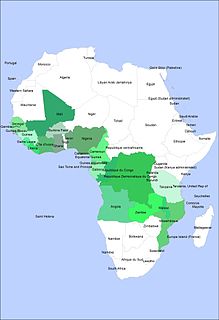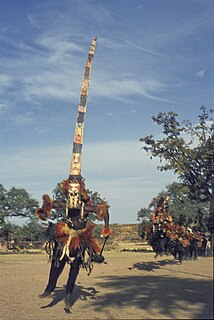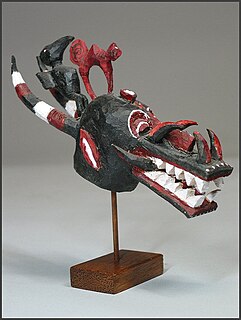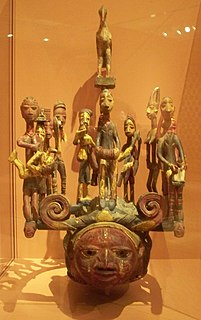 W
WTraditional African masks play an important role in certain traditional African rituals and ceremonies.
 W
WAwa, also known as the Awa Society, the Society of Masks, is an African mask and initiatory society of the Dogon people of Mali which is made up of circumcised men, and whose role is both ritual and political within Dogon society. The Awa Society takes an important role in Dogon religious affairs, and regularly preside over funereally rites and the dama ceremony—a ritual ceremony that marks the end of bereavement in Dogon country. This Society is one of the important aspect of Dogon religious life—which is primarily based on the worship of the single omnipotent, omniscient and omnipresent Creator God Amma and the veneration of the ancestors. Although it is only one aspect of Dogon's religious sects, it is perhaps more well known than the others partly due to Dogon mask–dance culture which attracts huge tourism, and their masks highly sought after, and in fact, one of the first to be sought after by art collectors in the west.
 W
WThe Benin ivory mask is a miniature sculptural portrait in ivory of Olu Atuwatse I, the first West African to be educated in a European university at Lisbon, Portugal in the 17th century. The masks were looted by the British during the Benin Expedition of 1897.
 W
WA Chiwara is a ritual object representing an antelope, used by the Bambara ethnic group in Mali. The Chiwara initiation society uses Chiwara masks, as well as dances and rituals associated primarily with agriculture, to teach young Bamana men social values as well as agricultural techniques.
 W
WMasks are the most important art form of the Dan people of Liberia. The Dan people refer to these masks as gle or ge, terms that refers both to the physical mask and the individual spirits the mask is believed to embody during masquerade performances.
 W
WAn Epa mask is a ceremonial mask worn by the Yoruba people of Nigeria during the Epa masquerade. Carvings representing priests, hunters, farmers, kings, and mothers are usually depicted on the masks. They are used to acknowledge important roles within the community, and to honor those who perform the roles, as well as ancestors who performed those roles in the past.
 W
WAn adorned wood face mask from the We (Wee) people of West Africa, dated to the 20th century is in the permanent African collection at the Indianapolis Museum of Art and on display in the Eiteljorg Suite of African and Oceanic Art.
 W
WThe Festival International des Masques et des Arts, or FESTIMA, is a cultural festival celebrating traditional African masks held in Dédougou, Burkina Faso. Founded to help preserve traditional cultural practices in the modern age, FESTIMA features masks and traditions from several West African countries. It is currently held biennially in even-numbered years. The most recent edition, the fifteenth, was held from February 29 to March 7, 2020 in Bankuy.
 W
WA kifwebe or bwadi bwa kifwebe is a mask of the Songye or Luba of the Congo.
 W
WThe kponyungo is a ritual mask created by the Senufo people, an ethnolinguistic group residing in Africa's Ivory Coast.
 W
WA lipico or lipiko is a mask or helmet of the Makonde of Mozambique.
 W
WThis Magbo helmet mask for an Oro society member was created by Yoruba artist Onabanjo of Itu Meko. It is currently located in the African collection of the Indianapolis Museum of Art, which is in Indianapolis, Indiana. Created around 1880-1910, it depicts a varied cast of community members carved of wood, colored with pigment, and mounted on a curved bar surmounting the helmet.
 W
WThe mask of Tutankhamun is a gold mask of the 18th-dynasty ancient Egyptian Pharaoh Tutankhamun. It was discovered by Howard Carter in 1925 in tomb KV62 in the Valley of the Kings, and is now housed in the Egyptian Museum in Cairo. The mask is one of the best-known works of art in the world and a prominent symbol of ancient Egypt.
 W
WN'tomo masks are used by the Bambara people of West Africa. There are six male initiation societies that young males must pass through before becoming a man. N'tomo Dyo is the first of these through which boys pass before their circumcision. The mask represents the legendary ancestor of the Bambara and it is a symbol of protection.
 W
WA Punu-Lumbo mask is a tribal mask native to the Ogooué River basin in Gabon, especially in the south in Ngounié Province. The masks are extremely valuable to collectors of African art, and have been sold at Sotheby's for well over $400,000. The earliest known example, collected in 1867, is part of the Pitt Rivers Museum collection at the University of Oxford. Several other museums, such as the National Museum of African Art in Washington, D.C. are in possession of one. They have been featured in the African Negro Art show at the Museum of Modern Art in New York City (1935), and at the Museum voor Volkenkunde, in Rotterdam (1953). The masks were popular among European collectors during the 1920s and 1930s.
 W
WWoyo masks are ritual masks made by the Woyo people of Central Africa.